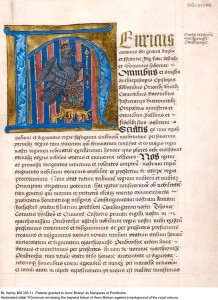
On this day in history, 1st September 1532, Anne Boleyn was created Marquis of Pembroke, a title in her own right, at Windsor Castle.
The record in Letters and Papers reads:
“”Creacion of lady Anne, doughter to therle of Wilteshier, marquesse of Penbroke.”
Sunday, 1 Sept. 1532, 24 Hen. VIII. The lady was conveyed by noblemen and the officers of arms at Windsor Castle to the King, who was accompanied by the dukes of Norfolk and Suffolk and other noblemen, and the ambassador of France. Mr. Garter bore her patent of creation; and lady Mary, daughter to the duke of Norfolk, her mantle of crimson velvet, furred with ermines, and a coronet. The lady Marques, who was “in her hair,” and dressed in a surcoat of crimson velvet, furred with ermines, with strait sleeves, was led by Elizabeth countess of Rutland, and Dorothy countess of Sussex. While she kneeled before the King, Garter delivered her patent, which was read by the bishop of Winchester. The King invested her with the mantle and coronet, and gave her two patents,—one of her creation, the other of 1,000l. a year. She thanked the King, and returned to her chamber.
Gifts given by the lady Marques :—To Mr. Garter, for her apparel, 8l.; to the Office of Arms, 11l. 13s. 4d. The King gave them 5l.
Officers of Arms present :—Garter and Clarencieux, kings; Richmond, Carlisle, and Windsor, heralds; Rougecross, Portcullis, Bluemantle, and Guisnes, pursuivants.”
A record of the valuation of her lands followed this record in Letters and Papers:
“Total of the lands of the lady Anne marchioness in Wales, over and above casualties not charged, 710l. 7s. 10¾d., out of which she is charged to pay by the King’s grants yearly, 199l. 5s. 11d., “which the tallage or knowledge money will discharge for the time; and after that, the fines for the sessions and the customs which be not charged in the value will discharge them.”
Sum of the lands in England : Corry Mallett, Soms., Hundesdon, and Estwyke, Herts, “lands late Philip Pary’s, in Hundesdon,” manors of Stansted, Roydon, Fylollyshall, and Cokkeshall, and Weston next Baldoke (value of each stated separately), 313l. 5s. 3¾d. Total for England and Wales by the last gift of the King, 1,023l. 13s. 2¾d.”
The special ceremony was followed by a sumptuous banquet in honour of the new Marquis of Pembroke.
Anne Boleyn was Henry VIII’s queen-in-waiting, not yet his consort because the struggled for the annulment of his marriage to Catherine of Aragon was still ongoing, so this title was a way of making Anne a suitable consort for the upcoming visit to Calais to meet Francis I of France. Anne required some status befitting of a future queen of England.
Source
- LP v. 1274